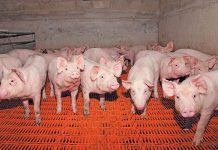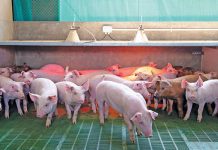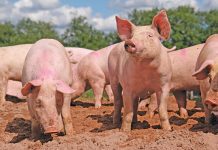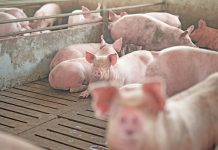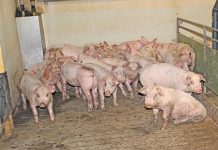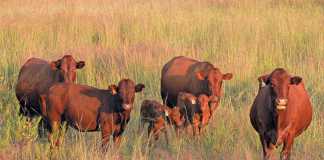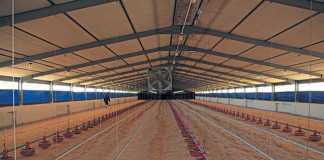
Photo: Annelie Coleman
“The ideal pig is a pig that makes money. And optimum profitability in pig breeding depends on an extended genetic base and artificial insemination.”
READ: Top pig stud gains from strong genetics
Coming from Arthur Gee, MD of South Africa’s largest producer of pork and the country’s leading supplier of breeding stock, these words carry weight. And they make even more sense after a brief look at the science of modern breeding and what it holds for the industry.
Kanhym Estates, based near Middelburg in Mpumalanga, is the South African franchise holder of PIC (Pig Improvement Company) International and runs a pig artificial insemination (AI) station at its premises near Middelburg that supplies world-class genotypes to commercial pig producers.
“Our linkage with PIC International in the UK strengthens our position as industry leader. PIC is a world leader in pig genetics and the genetic improvement of the pig industry,” Gee explains.
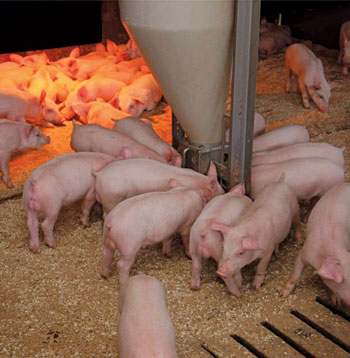
Artificial insemination allows a farmer to bring superior sire lines into the herd across many females.
The Kanhym AI station, which is benchmarked against the best in Europe, houses 150 superior PIC sires.
“Genetic development in South Africa has gained momentum during the last five years,” he says.
“One can see this in increased sow production and a decrease in sow and grower pig (finisher) mortality. We currently distribute two PIC terminal sires – PIC 337 and PIC 410 – in South Africa. PIC 337 is the undisputed world leader in the terminal sire market and combines lowest cost of production with a high quality carcass. It’s also known for increased lean growth rate, low backfat and exceptional feed efficiency.
“PIC 410 is PIC’s newest addition. It is a hybrid boar that combines high primary yield, leanness and robustness with an excellent growth rate, feed conversion, carcass leanness and meat quality.”
Herd fertility
Gee stresses the importance of herd fertility – and why AI offers unbeatable advantages.
“The ultimate aim of any breeding programme is to increase the profitability of commercial pork production. AI dominates reproduction management on pig farms in South Africa because it brings superior sire lines into the herd and across many sows, something not normally achievable through natural mating.
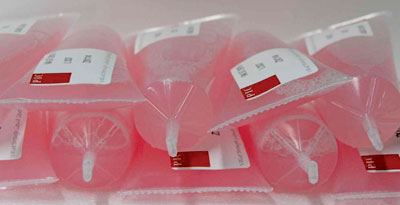
Kanhym currently has 60% of the pig semen market in South Africa. The company houses 150 superior PIC boars. Photo courtesy of Kanhym.
“The AI process also results in improved quality semen, as each ejaculate can be tested for semen viability before it is processed into AI doses. This is impossible in natural mating.”
READ: Pig breeder takes his stud to the top
The Kanhym AI boars are selected according to PIC’s international BLUP (best linear unbiased prediction) comparisons and have been performance- and conformation-tested.
They are halothane-negative and housed in a controlled environment with optimal ventilation and temperature to ensure superior semen quality.
According to Alteli de Villiers, Kanhym’s technical advisor, semen must always be kept at
16°C to 18°C, as its viability is greatly reduced outside this range.
For this reason, the temperature in the laboratory, the equipment and reagents used in semen production, as well as the cooling gradient from production to packaging and transportation, are managed with extreme care.
Market leader
Kanhym AI industry, which started in the mid-1990s, today has 60% of the pig semen market in South Africa, thanks to its link with PIC.
In addition, the company exports genetics in the form of live boars and gilts to Uganda, Mauritius, Swaziland, Lesotho, Zambia, Angola and Botswana.
“PIC is the international leader in providing genetically superior pig breeding stock and technical support to maximise the genetic potential of the global pork chain,” explains Gee.
“We comply with strict operating procedures to ensure semen quality. External specialists, including local veterinarians, supervise our operation and experts from the company Minitub in Germany regularly audit it.”
Minitub is the market leader of process systems, equipment and consumable products for the assisted reproduction industry in livestock.
Gee adds that PIC goes beyond BLUP to achieve genetic improvement. In addition to the estimated breeding values (EVBs), its technicians take cross-breeding values (CBVs) into consideration to evaluate the performance of both dam line and sire line crosses in various environments and localities.
READ: Getting started with pigs – 1
CBVs allow growth, robustness, mortality and carcass traits to be predicted more accurately.
“We aim to breed well-balanced animals,” explains Gee.
“The PIC genetic base includes a variety of traits and breeding values. Pig breeders often over-emphasise one or more of the traits in which their specific breeds or breeding lines excel. But that doesn’t necessarily make economic sense.
“A holistic approach that identifies breeding objectives ensures optimal sow production and grower pig performance. A well-balanced pig is a profitable pig – and that is what we strive for.”
Email Alteli de Villiers at [email protected] or Arthur Gee at mailto:[email protected].
This article was originally published in the 08 June 2012 issue of Farmer’s Weekly.

